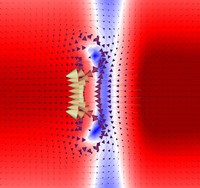Dissipation Mechanisms in Fermionic Josephson Junction

The flow pattern through the atomic Josephson Junction for the dissipative case in the unitary Fermi gas. The formation of quantum vortices is visible. Fig. was taken from arXiv:2207.06059.
G. Wlazłowski, K. Xhani, M. Tylutki, N.P. Proukakis, P. Magierski,
Dissipation Mechanisms in Fermionic Josephson Junction,
Phys. Rev. Lett. 130, 023003 (2023) [arXiv:2207.06059].
The paper contains the reproducibility pack.
The paper characterizes numerically the dominant dynamical regimes in an ultracold superfluid fermionic Josephson junction, focusing on the differences in strongly and weakly interacting limits.The dissipation in the strongly interacting regime occurs through the phase-slippage process, caused by the emission and propagation of quantum vortices, and sound waves - similar to the Bose-Einstein condensation limit. Instead, in the weak interaction limit, the main dissipative channel arises through the pair-breaking mechanism.
